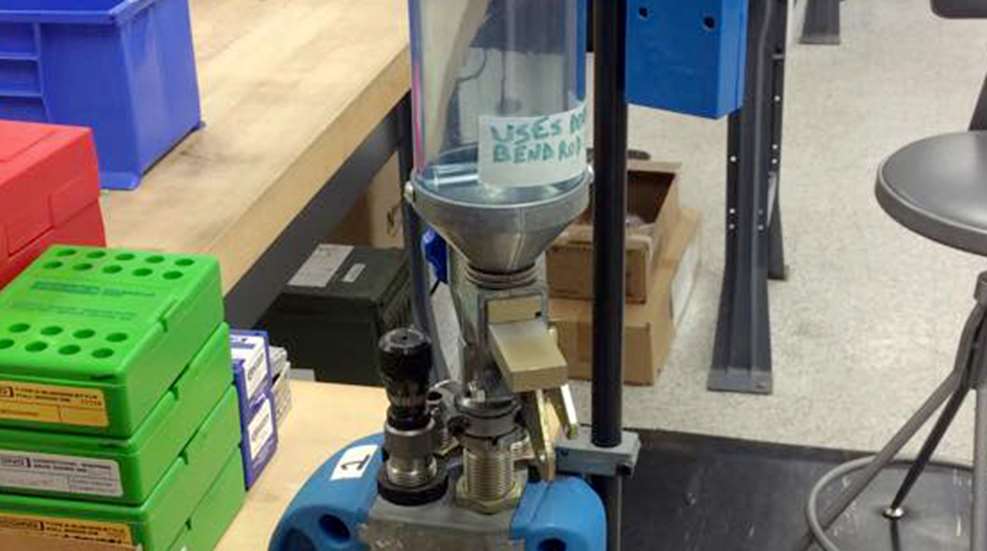
Last week, we addressed single-stage vs. progressive presses for the beginning handloader, and made the experience-based case that beginners would be better served by starting on a single-stage press.
CAVEAT: While many progressive presses are seen in photos of our handloading shop, remember that ALL of our powder charges are weighed by hand. We do not use powder measures on our presses. Progressives at our shop are used for preparation of brass, priming, seating, etc., but not for fully-progressive loading.
For those interested in progressives, we’ll examine different key features among the types and relate them to handloading processes. The first, and simplest, type is the manually-advanced progressive. The shellplate holds the several cartridges being processed with each stroke of the handle. On these, the loader must manually advance the shellplate after each handle stroke.
While this obviously slows production vs. a press which cycles the shellplate automatically, this feature does have some advantages. (The disadvantages follow shortly.) No case is advanced to the next station until the operator deliberately does so—which is especially helpful for the new handloader.
Problems that arise during loading can be diagnosed and fixed without fears of some “extra” process happening with cartridges at the other stations. NOTE: One way to positively prevent this phenomenon is to remove the cases from each press station when a problem emerges, before beginning diagnosis. Often, however, experienced loaders omit this step as a time-saving measure, being confident in their understanding of the loading process, machine and remedy. If all cartridge cases are left in place, the loader must monitor what’s happening at each station. For example, raising the press ram twice may result in a double-charge of powder. With rifle cartridges, this usually results in a massive powder over-flow, alerting the loader to the problem.
With pistol cases or small rifle charges in large cases, such an over-flow isn’t guaranteed. The manually advanced progressive keeps all operations under the loader’s control at all times. This seems intuitively easier for the beginning loader to understand and to operate with confidence. However, this same characteristic can be problematic if the loader isn’t paying 100 percent attention to what they are doing. Some handloaders apparently prefer to load progressively while daydreaming and paying little attention to the operation. Their plan is to feed components in, like feeding potato chips to a monkey, while good ammo drops out at the other end. Unfortunately, such an approach may well result in something other than “good” ammo dropping out the end—just as happens with the monkey!
Forgetting to cycle the shellplate will also cause problems. As with all handloading, distractions MUST be kept to a minimum for safety purposes. Never watch TV, talk with friends, or have other distractions (such as a rambunctious child or pet) in the room when loading. Avoiding distractions will do much to ensure consistent, high-quality ammunition, free of defects.
For example, when a case doesn’t line up correctly with the case mouth expander or powder drop tube, a difference in “feel” often alerts the loader to correct the problem, avoiding a ruined case. If one is interrupted or becomes distracted, be certain to examine all cases in the shellplate before resuming loading.
Other advantages of the typical manually-advanced progressives are that they are usually simpler in design, and have fewer moving parts to get out of adjustment. This appeals to the mechanically disinclined! Caliber conversion kits are usually cheaper and take less time to install. This especially benefits the enthusiast who reloads for a wide variety of calibers. However, many popular manually-advanced progressives have fewer die stations than the higher-end auto-advancing machines. One item that is very useful when actually dispensing powder on a progressive press is a powder-level sensor. This warns if powder levels are too high or too low.
This condition often results from powder “bridging” in the powder measure. That is, one charge doesn’t fully empty into its cartridge case, leaving some extra powder hanging up in the measure to join the normal charge on the next case.
With some extruded powders, this can be quite obvious without a sensor. However, the sensor can detect small variations that would not be obvious to even an experienced, attentive operator. Looking at the machine’s potential for a powder sensor, in addition to one’s other customary dies is a wise idea.
Similarly, pistol shooters are best served to seat bullets and crimp cartridges in separate operations. This should be taken into account when selecting a progressive press. Whenever loading fully-progressively, choosing powders that dispense very easily, such as ball/spherical or very fine-grain extruded powders, can help keep charges quite uniform.
The next type of press advances the shellplate automatically each time the handle is cycled. Read our article on this type of press and its particular advantages and drawbacks.
SSUSA thanks the U.S. Army Marksmanship Unit for allowing the reprint of this article.

































